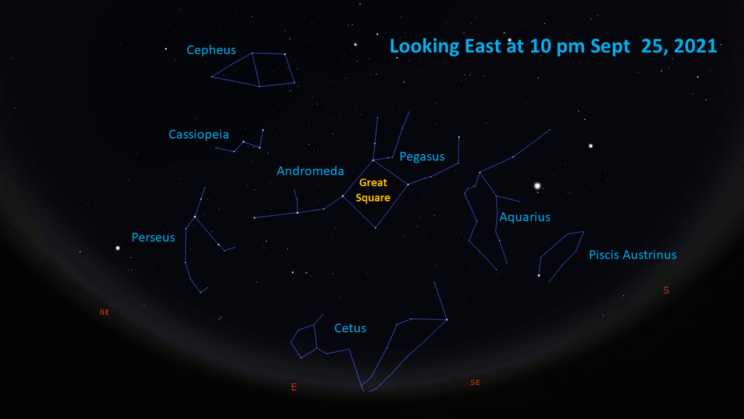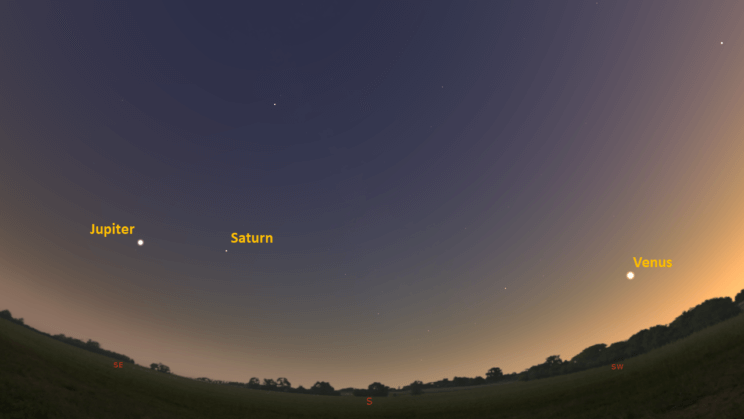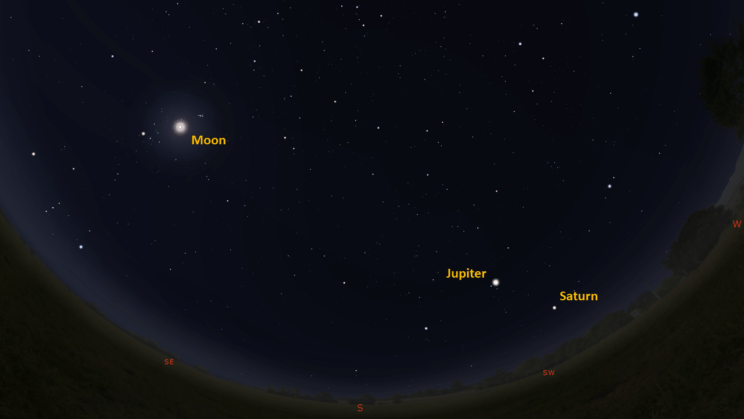This is the Saint Louis Science Center’s NIGHT SKY UPDATE for the week of Friday, September 24, 2021.
Information updated weekly or as needed.
Times given as local St. Louis time, which is Central Daylight Time (CDT). For definitions of terminology used in the night sky update, click the highlighted text. If relying on times posted in Universal Time (UT), St. Louis is -5 hours when CDT.
Public Telescope Viewings
With the changing recommendations from the CDC regarding COVID-19, conversations regarding the return of star parties at the Saint Louis Science Center have begun. We are close to bringing back our public telescope viewings, but a few details still need to be worked out. We will post future updates as we learn more about when we can bring back telescope viewings.
Observing Highlight of the Week

View of fall constellation rising in the east.
Image created using Stellarium.
With the recent change of seasons, it seems appropriate this week to talk about a pattern of stars that helps define the fall sky. This pattern is the asterism called the “Great Square of Autumn.” Asterisms are patterns of stars that do not make up one of the official 88 constellations as determined by the International Astronomical Union. Like constellations, asterisms can help us explore the sky. In addition to being tools for wayfinding, they also make fine targets to observe. Some, like the Great Square of Autumn are easy to find, while others tend to be small and might require optical aid to see. One such asterism is Kemble’s Cascade in the constellation Camelopardalis.
Imaging patterns in the stars was a major component of how humans started to see consistency and predictability in the world around us. For example, the annual shift in visible constellations is one way to track the changing seasons. Asterisms also do this, which brings us to the Great Square of Autumn. This asterism can be found rising in the east after sunset this week. When low to the east, it appears as a square that is balancing on a corner. Larger asterisms like the Great Square or the Summer Triangle are often connected to several constellations. The Great Square is part of the constellations Andromeda and Pegasus. The four stars that make up the square are Alpheratz in Andromeda and Scheat, Markab and Algenib in Pegasus.
Once you find the Great Square, find constellations around it. You can do this with a simple star map and some star hopping. Start with the stars Algenib and Alpheratz, the two on the east side of the Great Square. If you follow the direction they point to the north, you will find the W-shape of Cassiopeia. If you follow the direction they point to the south, you will find the star Diphda, which is the tail of the constellation Cetus. Going back to the star Alpheratz, you may note an ice cream cone shape of stars extending to the northeast away from the star. This is the constellation Andromeda. Continuing northeast from the cone shape, you will find an upside-down Y-shape of stars; this is Perseus.
Moving to the west side of the Great Square, we will use the stars Scheat and Markab. Pointing north, these take you to the house shape of Cepheus, and pointing south, they take you to the bright star Fomalhaut in the constellation Piscis Austrinus. The region between Fomalhaut and Markab is mostly the constellation Aquarius. Finally, Scheat and Markab form part of a wing in the constellation Pegasus.
With the fall sky laid out, we can move on to individual targets. Numerous objects can be found in the section of sky organized by the Great Square. Stars, star clusters and galaxies are a few of the options we can look for. For those without an optical instrument, stars are interesting targets. The color of stars or variable stars are all good choices. Looking at the four stars of the Great Square, three of them are blue and one is red. The color of stars is interesting for several reasons, but the Hertzsprung-Russell Diagram is a good place to start. Another star to track down is the variable star Mira. Found in Cetus, Mira is a long period variable star that is normally too faint to see with the unaided eye. That said, Mira varies in brightness on a period of roughly 330 days. Due to this variance in magnitude, Mira periodically becomes bright enough to see without binoculars or telescope. Mira’s visual magnitude typically varies from 3.5 to 9.0; currently it appears as a 6.5 magnitude object and will require binoculars to be seen. Mira last reached its maxima in August and has already faded out of naked eye visibility. Mira’s next maxima is predicted to occur around July 16, 2022.
For those with binoculars, there are a handful of bright deep sky objects that will make fine targets in the fall sky. Try the Andromeda galaxy in Andromeda, the Perseus Double Cluster (NGC 869/884) in Perseus and Messier 15 in Pegasus. The key to finding these objects is a decent map of the constellations. These objects are observable in light-polluted skies and can be found using 7×35 binoculars and up.
The fall sky offers observers many targets of interest. Don’t feel like you must see everything in one night! Spread things out over time. Start with a few constellations, and once you can routinely find them each night, pick one to focus on. See if you can identify each of the bright stars that make up the constellation. Knowledge of the star fields is key to moving on to the fainter targets you are interested in. For the next three months, the area of sky around the Great Square of Autumn will be visible most of the night. Take your time and enjoy what fall has to offer.
The Sun and Moon

The Moon as seen from the International Space Station, on July 31, 2011.
Credit: NASA
Sunrise is at 6:51 a.m. on Friday, September 24 and sunset is at 6:54 p.m., providing us with roughly 12 hours of daylight. Even after sunset, the light from the Sun will dimly illuminate our sky for roughly 1 hour and 30 minutes. This period is called twilight, which ends around 8:28 p.m. this week. For those with a sundial, local noon occurs around 12:52 p.m. this week.
| Day | Sunrise | Sunset |
|---|---|---|
| 2021-09-24 | 6:51 a.m. | 6:54 p.m. |
| 2021-09-25 | 6:51 a.m. | 6:52 p.m. |
| 2021-09-26 | 6:52 a.m. | 6:51 p.m. |
| 2021-09-27 | 6:53 a.m. | 6:49 p.m. |
| 2021-09-28 | 6:54 a.m. | 6:48 p.m. |
| 2021-09-29 | 6:55 a.m. | 6:46 p.m. |
| 2021-09-30 | 6:56 a.m. | 6:45 p.m. |
| 2021-10-01 | 6:57 a.m. | 6:43 p.m. |
| 2021-10-02 | 6:58 a.m. | 6:41 p.m. |
Moon
Moonrise for Friday, September 24 occurs at 8:58 p.m. and moonset occurs at 11:19 a.m. on the following day. On Friday, September 24 the Moon will exhibit a waning gibbous phase with about 85% of the lunar disk illuminated. Last quarter moon occurs on September 28 at 8:57 p.m.
International Space Station (ISS) Observing

Visible passes of ISS from St. Louis for the week of September 24 occur during evening hours. The best passes this week occur on the evenings of September 30 and October 2. Use the table below for information about these and other visible passes this week.
Catch ISS from St. Louis starting Friday, September 24
| Date | Starts | Max. altitude | Ends | |||||||
|---|---|---|---|---|---|---|---|---|---|---|
| Time | Alt. | Az. | Time | Alt. | Az. | Time | Alt. | Az. | ||
| 28 Sep | -1.3 | 20:19:18 | 10 | NNW | 20:20:51 | 13 | NNE | 20:21:05 | 12 | NNE |
| 29 Sep | -0.8 | 21:07:56 | 10 | NNW | 21:08:33 | 14 | NNW | 21:08:33 | 14 | NNW |
| 30 Sep | -1.9 | 20:20:51 | 10 | NNW | 20:23:06 | 20 | NNE | 20:23:06 | 20 | NNE |
| 1 Oct | -1.6 | 19:33:50 | 10 | NNW | 19:36:01 | 16 | NNE | 19:37:41 | 12 | NE |
| 1 Oct | -0.8 | 21:09:53 | 10 | NW | 21:10:40 | 16 | NW | 21:10:40 | 16 | NW |
| 2 Oct | -2.9 | 20:22:40 | 10 | NW | 20:25:20 | 41 | N | 20:25:20 | 41 | N |
Magnitude (Mag): The Measure of brightness for a celestial object. The lower the value is, the brighter the object will be.
Altitude (Alt): The angle of a celestial object measured upwards from the observer’s horizon.
Azimuth (Az): The direction of a celestial object, measured clockwise from an observer’s location with north being 0°, east being 90°, south being 180° and west being 270°.
For information about ISS flyovers and other visible satellites, visit www.heavens-above.com
Detailed information regarding all unmanned exploration of our universe, missions past, present, and planned, can be found at Jet Propulsion Laboratories:
The Visible Planets

Looking South, at 7:15 p.m. September 25, 2021. Credit: Stellarium, EG

Looking south, at 1:00 am, September 26, 2021. Credit: Stellarium, EG
This week, three naked eye planets are visible. Venus can be found in the west after sunset. Jupiter and Saturn can be found in the southeast after sunset
Venus
Venus is well into another evening apparition. By 7:15 p.m., Venus will be about 13° above the western horizon. Venus will set at 8:35 p.m. As 2021 continues, Venus will continue to elongate from the Sun until October 29 when it reaches maximum eastern elongation. After this date Venus will start to head back towards the Sun as it approaches inferior conjunction on January 8, 2022.
Jupiter
Jupiter has passed opposition and as such will be visible about 30 minutes after sunset. Look for Jupiter in the south as it starts to darken outside. Jupiter sets at 3:37 a.m. tomorrow morning and will set about 30 minutes earlier each week. Jupiter reaches superior conjunction on March 5, 2022. This means we can count on seeing Jupiter in the south for the rest of this year and well into 2022.
Saturn
Saturn is past opposition which means it will be visible about 30 minutes after sunset. Right now, it can be found in the south after sunset, but as we continue through the year, Saturn will set about 30 minutes earlier each night. Saturn sets at 2:16 a.m. Saturn will reach superior conjunction on February 4, 2022.
James S. McDonnell Planetarium
Night Sky Update: September 24-October 2, 2021






